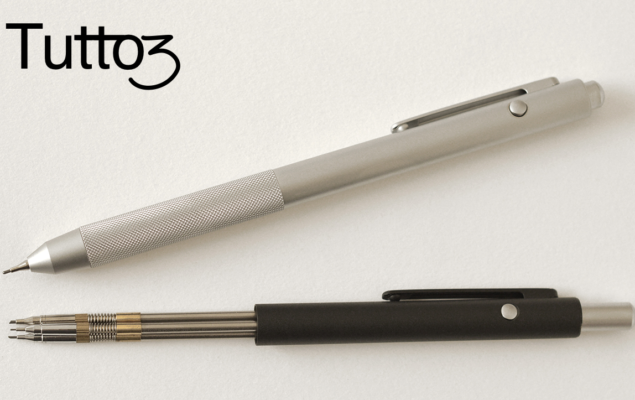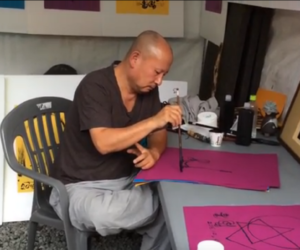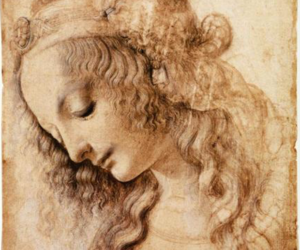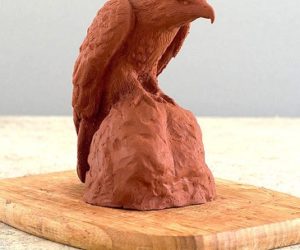Dear friends, I hope you are doing great and are very creative!
I was glad to receive this article that Ethan Molina sent me and which I'm publishing here:
The Top 5 Mechanical Pencils for Drawing and Sketching
Usually when an artist creates, he submerges into his activity so intently, that he forgets that the world is still making its way around the Sun. His pencil should be as close as an extension of his body, and it should be as effortless, as possible. It should cause him the least distractions, and should not make him tired. Therefore I recommend:
2. A solid grip: Squishy, rubbery or soft handles make more difficult the precise control of your tool for drawing and draftsmanship. If you want precise drawing, I recommend you to look for a solid grip.
3. A round shape: There are pencils which claim to be “ergonomic” and have strange or uneven shapes. Sometimes they feel good when you first hold them, but they only work in one position. When an artist is drawing, he continually rotates his pencil around to get the desired point (either the flat spot of the lead, or to the contrary, the sharper edge). When you turn an ergonomic grip around, even so slightly, it becomes totally anti-ergonomic and ridiculously uncomfortable. A similar thing happens when you try to hold the pencil further away, or closer to the tip, than what the grip was designed for. Avoid them.
4. The thickness: The pencil should fit and stay on your fingers with the least effort. Keeping this in mind, avoid the thin and the too thick bodies. For me a pencil that is slightly thicker than a regular wooden pencil is the ideal.
5. Weight: It should have some weight to it, but it should not be super heavy, and neither too light. I think most of us tend to like objects that have some weight to them. They just feel of a better quality. Not super heavy, but with weight so that gravity keeps them in your hand.
6. A fully retractable sleeve: I have had more than one mechanical pencil falling off my table and breaking the metal sleeve of the tip. The ones that retract fully, protect themselves when not in use. Additionally, the ones that don’t retract can make holes in your breast pocket or the pocket on the back of your pants when carrying them, which can be a pain in the butt! (Literally!)
1. Softness: The regular lead for mechanical pencils is the HB, which for drawing it’s a “medium” softness. They are usually available in a range from 2H (hardest) to 2B (softer). The best for you may depend on what you are trying to do (obviously), and on the paper you are using. A paper with more “tooth” (grain) will “bite” on the graphite and your mark will look darker. While smooth papers will hold less graphite and your mark will be lighter.
2. Thickness: The common mechanical pencil leads are 0.3mm, 0.5mm and 0.7mm. There are also 0.9mm, although the replacement leads may be a bit hard to find, depending on where you live.
The Tutto3 has 3 different caliber of leads and it comes with 3 different hardnesses as well: 0.3mm 2H (hard), 0.5mm HB (medium) and 0.7mm B (soft). Therefore it covers a wide range, to create different effects. An excellent idea. It is one of those things that once you get used to working with them, you can hardly understand why you didn’t have one of these much earlier. I have been lucky to be one of the original users of this pencil, and nowadays when I draw with another pencil, I feel something is missing: Where are my other leads?
It is a bit of a mystery where this mechanical pencil came from, since it is not from one of the monster companies such as Pentel, Staedlter, etc. It seems it is a private artist who produces this tool in partnership with an established German manufacturer and an American company called O Art International (it is physically made in Japan, as most quality mechanical pencils are).
Reminds me of those old pens which contain different color tips in one. (An old concept put to a new use). The Tutto3 has a slick mechanism based on gravity. To select a lead you simply look at the label of the one you want, and by holding the pencil in that position (and thanks to one of Newton’s laws), that point will come out when pressing the back button.
The pencil has a confortable thickness and a classic and effective anti-slip knurl grip, similar to other drafting pencils, except that this area has ben extended, so that you can hold it further away from the tip (for drawing) and you will still be on the anti-slip grip.
It has a good looking carrying clip and a small eraser under the back button.
This pencil was conceived by an artist, for artists, and in my opinion it accomplished its goal: In today’s market it’s the best mechanical pencil for drawing.
Not so good points: Hard to find one, but if you want me to be really picky, the 3 way mechanism rattles a little if you shake the pencil. Not a problem and this is normal in multifunction pens, but I had to find something to say here!

The first impression when you hold the rOtring 600 is that of a quality instrument. It is made out of brass which gives it a nice weight. It has a knurled grip that is confortable and provides a good anti-slip hold. The central part of the body has a hexagonal shape, reminiscent of the older wooden pencils. The body is continued with a rounded part where the clip and the lead hardness indicator are located. The clip is sturdy, made from the same brushed aluminium as the pencil with the rOtring inscription embossed. The lead hardness indicator is also a knurled ring.
The fixed sleeve, however, makes it not exactly pocket friendly (as the pointed tip always stays out). The cap is standard, also made of brushed aluminium and it hides a small eraser.
The feeling is that of a solid instrument, one that won’t let you down. I have used the rOtring for many many hours. I have to say this was my favourite drawing pencil until I found the Tutto3.
All in all a fantastic, near perfect pencil with a nice design and feel. This is a tool that I recommend.

I have to say, this pencil is a bit strange looking, with a strikingly large clip and the dots on the grip area, which is made up of a combination of a knurl, with little elliptical rubber inserts. Obviously this is an attempt to try to get the best of both worlds, and I’m pleased to say it’s reasonably successful. It offers a firm grip, yet still has a bit of softness about it when you are holding the pencil.
Then there is that huge, protruding pocket clip, which they call a document clip, a reference to how you can clip it to a thick folder or sheaf of papers. This pencil may not be of the same quality as the prior 2, however, still an excellent working pencil which should last you a long time.
The sleeve is fully retractable, with a push top ratchet lead advance mechanism. Similar to a ballpoint pen, pushing the top button first pushes out the tip section with its 4mm lead sleeve. Further operation of the top button advances the lead like a normal push button mechanical pencil. The mechanism only advances a very short length of lead each time. Once out, the sleeve is a fixed sleeve, but pulling the document clip automatically retracts the tip section for safety.
The Graphgear 1000 is available in 0.3mm, 0.5mm, 0.7mm and 0.9mm options, distinguished by different coloured rubber inserts in the grip section. The body is made out of aluminium.
Not So Good Points – The lead advances by very short increments, which can get annoying. I would have preferred a little more weight to it.
To get it, click here.
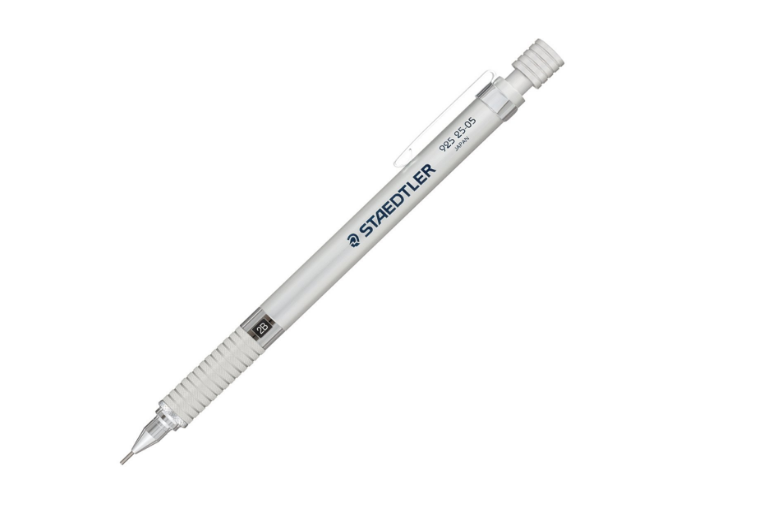
It is available in 0.3mm, 0.mm, 0.7mm, and 0.9mm. It features a lead grade indicator. The grip area with its texture and the concentric grooves are very efficient in keeping your hold. Although some may say it is a bit too rough to the feel.
Up at the upper end there is a standard button or cap. On the top of it is a very large “.5” indicating the lead diameter of the pencil.
Not So Good Points – The fixed, not-retractable sleeve. I would have liked a little heavier weight to it.
To get the Staedtler 925 25, click here.

The lead advances using the same top button, but pressing it lighter. You do have to be a little careful as you can inadvertently push too hard and retract the tip, rather than just advance the lead. Once you get used to it you don’t have to think about it. It conceals an eraser under the top cap. It’s small, but efficient.
The Pilot Vanishing Point is made of matt black plastic, with nice shiny chrome trims. It is very aesthetic. The body is smooth, without an anti-slip grip area, which may be my only point of complain. The 4mm long lead sleeve is for drawing and draughting work. The band toward the center of the pencil is an adjustable lead hardness indicator.
Not So Good Points: The lack of anti-slip grip. It’s made out of plastic. (I still love it, I have to confess).
Ethan Molina

